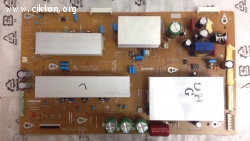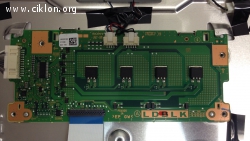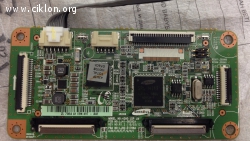Книги и списания за електроника
Newnes Guide to
Television and Video Technology
K. F. Ibrahim
4th edition - First edition 2007
Preface
This new edition of Newnes Guide to Television and Video technology
continues the tradition of providing a comprehensive and up-to-date cov-
erage of video and television technology first started in 1958 by J. F. Camm.
In 1968 the book was completely re-written by Gordon J. King and updated
by him in 1972. Eugene Trundle took over in 1988 with a further re-write
and subsequent updates in 1996 and 2001. It is now my turn with a new re-
write to take this publication into the digital age of the 21st century, the age
of flat-panel displays, high-definition television, Blu-ray technology and
internet video streaming; the age of multimedia convergence in which the
various strands of video, television and communication technologies over-
lap and complement each other.
The book starts with television fundamentals and builds up to multi-
media convergence going through video displays, television receivers,
recoding and playback systems. The first two chapters cover the principles
of monochrome and colour television and the fundamentals of analogue
TV broadcasting. This is followed by video compression for standard and
high-definition and audio-compression techniques (Chapters 3–6) that are
a prerequisite for digital video broadcasting and streaming. Chapter 7
deals with MPEG transport stream followed by Chapter 8 which explains
the various types of modulation used in broadcasting digital television
signals via satellite and terrestrial aerials.
The following four chapters deal with display devices. An overview of
the requirements of a TV receiver is given in Chapter 9 together with a
description of the traditional, and still widely used, cathode ray tube (CRT).
Detailed explanation with extensive block diagrams and practical circuits of
flat panel displays: Plasma, LCD, DLP and SED are given in Chapters 10–12.
Chapters 13–18 use the knowledge acquired in the preceding chapters to
give detailed description of television receivers using plasma panels, LCDs
and DLPs as well as CRTs encompassing the latest commercially used tech-
niques. Chapter 15 is exclusively dedicated to a generally neglected topic:
power-supply generation. Power-supply requirements and circuitry for dif-
ferent systems are included in the relevant chapters. Projection systems
including 3-dimentional techniques are covered in Chapter 19.
DVD playing systems (DVD, HD DVD and Blu ray) and magnetic tape
recording are dealt with in Chapters 20 and 21 leading to digital recording
and camcorder (Chapter 22) including recordable DVDs. The latest in
cable and on-line television broadcasting are described in Chapter 23 and
multimedia convergence in Chapter 24. Finally, the different types of ports
and inter-connectivity are listed and explained in Chapter 25.
Throughout my years of teaching, I have found that looking at faulty
systems and understanding their causes and symptoms is a powerful tool
to understand their inner workings. It is only when you know the effect a
faulty component or a malfunctioning chip can you truly say you under-
stand how that system works. For this reason, I have included a section on
common faults, their symptoms and their causes together with practical
fault diagnosis procedures in relevant chapters. Eight appendices are also
included to provide extensive background information from dBs to the
seven-layer OSI communication model.
My appreciation and thanks go to my college, College of North West
London and specially to the then head of my faculty, Frank Horan, for giv-
ing me the opportunity to develop and deliver courses on video and tele-
vision technology that made writing this book possible at the time when
colleges, encouraged by government funding mechanisms, were closing
engineering courses in favour of hairdressing and beauty therapy. The
neglect of engineering and technology and the obsession with the service
sector is short sighted and a highly dangerous path to take for colleges as
it is for governments. Just how many nail bars can a High Street sustain!
It is my hope that this book will make a contribution towards the promo-
tion and understanding of engineering and technology.
K. F. Ibrahim
Подкрепете този сайт (CiklonElectro)
Категории
Препоръчани файлове
Обяви
-
Плазмени телевизори / Logic Boards
15.01.2025 г.Платки от плазмен телевизор със счупен дисплей.
-
Телевизори / LCD телевизори
13.03.2025 г.Платката е работеща, от ТВ с дефектен дисплей.
-
Плазмени телевизори / Y-SUS платки
15.01.2025 г.Платки от плазмен телевизор със счупен дисплей.
-
Телевизори / LCD телевизори
13.03.2025 г.Платката е работеща, от ТВ с дефектен дисплей.
-
Телевизори / Плазмени телевизори
13.03.2025 г.Платката е тествана,от TV със счупен дисплей 42T30010
-
Телевизори / LCD телевизори
13.03.2025 г.Платката е от ТВ със счупен дисплей.
-
Телевизори / LCD телевизори
13.03.2025 г.Платката е от ТВ със счупен дисплей.
-
Телевизори / Плазмени телевизори
15.01.2025 г.Платката е тествана,от TV със счупен дисплей 42T30010
-
Телевизори / LCD телевизори
13.03.2025 г.Платката е от ТВ със счупен дисплей.
-
Плазмени телевизори / X-SUS платки
13.03.2025 г.Работещи платки от уред със счупен панел
-
Плазмени телевизори / Logic Boards
13.03.2025 г.Работещи платки от уред със счупен панел
-
Плазмени телевизори / Logic Boards
15.01.2025 г.Платки от плазмен телевизор със счупен дисплей.
-
Телевизори / Плазмени телевизори
13.03.2025 г.Платките са тествани,от TV със счупен дисплей 42T30010
-
Плазмени телевизори / X-SUS платки
15.01.2025 г.Платки от плазмен телевизор със счупен дисплей.
-
Телевизори / LCD телевизори
13.03.2025 г.Платката е от ТВ със счупен дисплей.
















